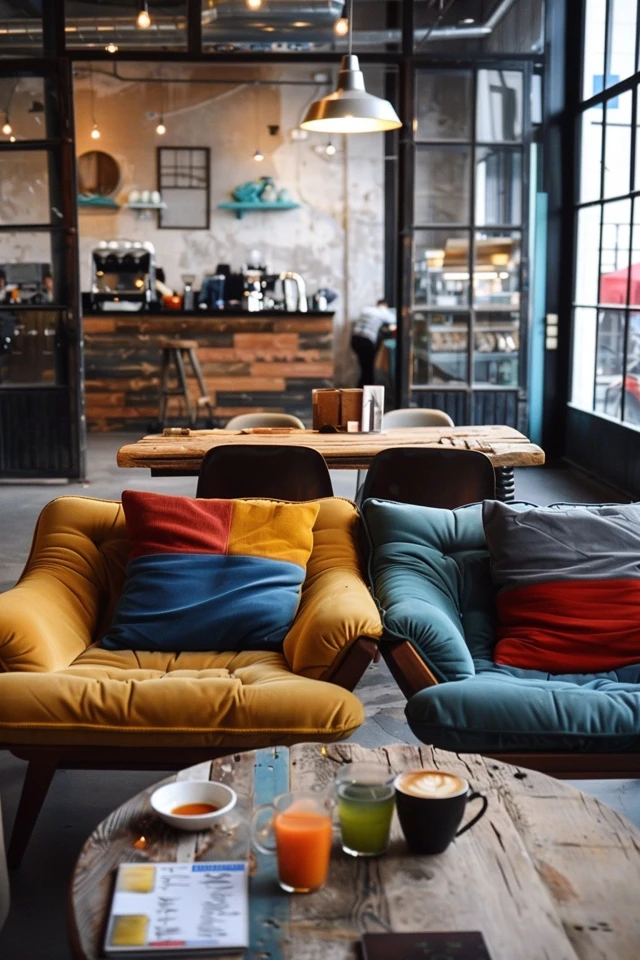Industrial interior design is an enduringly popular style, with a particular fascination for rustic industrial decor. This style effortlessly combines raw, unfinished elements with more refined touches, resulting in a unique and captivating aesthetic. The roots of industrial interior design can be traced back to the restoration of old warehouses into urban lofts, where exposed architectural features like iron or wooden beams, brick walls, cement floors, ductwork, and expansive windows created a distinct charm.
Rustic industrial decor embraces a neutral color palette and distressed materials, contributing to a relaxed and welcoming atmosphere. To achieve this style, consider using a natural palette and incorporating textures that showcase a blend of modern and rustic elements. Opening up the space, incorporating industrial style lighting, utilizing loft-type windows, adding metal accents, exposing structural elements, and incorporating industrial style decor are all key elements of crafting a unique and authentic industrial room.
Key Takeaways:
- Industrial interior design combines unfinished elements with polished touches, resulting in a captivating mix.
- Rustic industrial decor embraces a neutral color palette and distressed materials, creating a relaxed atmosphere.
- Elements of industrial room design include using a natural palette, mixing modern and rustic elements, and incorporating industrial style lighting.
- Loft-type windows, metal accents, exposed structural elements, and industrial style decor add authenticity to the space.
- Industrial room design is versatile and offers a unique blend of urban and rustic aesthetics.
Industrial Room Color Palette & Textures
When it comes to industrial interior design, the color palette and textures play a significant role in creating a unique and visually appealing space. The industrial room color palette typically includes neutral browns, whites, and blacks that complement the rustic charm of this style. Different shades of brown and tan can be paired together to create a warm and relaxed atmosphere, while white elements can be added to give the room a clean and bright look. To add contrast and character, incorporating black accents is a popular choice.
Textures are another essential component of industrial interiors, as they add depth and visual interest to the space. Distressed leather is a favored choice for furniture, bringing a touch of rugged elegance to the room. Plain white walls provide a clean backdrop that allows other elements to shine, while black metal accents add an edgy and industrial touch. Combining these textures creates a harmonious balance between rustic and modern elements, resulting in a space that is both inviting and visually captivating.

The combination of neutral colors and distressed textures is key to achieving an authentic industrial look.
By carefully choosing the industrial room color palette and experimenting with a variety of textures, you can create a unique and personalized industrial interior that reflects your style and personality. Let your imagination guide you as you explore the endless possibilities of colors and textures to make your industrial-inspired space truly exceptional.
Industrial Room Color Palette & Textures at a Glance:
- Neutral browns, whites, and blacks form the foundation of the industrial room color palette.
- Pair different shades of brown and tan to create a relaxed atmosphere.
- Add white elements for a clean and bright look.
- Incorporate black accents to create contrast and add character.
- Textures such as distressed leather, plain white walls, and black metal accents add depth and visual interest.

Creating an Industrial Open Floor Plan
When it comes to industrial style living, open floor plans are a perfect fit. Reminiscent of urban lofts, an industrial open floor plan brings together different functional areas to create a cohesive and expansive living space.
The key to creating an industrial open floor plan is the seamless connection between the living room and the kitchen. A kitchen island acts as a natural divider while still allowing a smooth flow between these two spaces. Incorporating a dining table into the layout further enhances the functionality and versatility of the area.
In addition to the main living areas, the bedroom can also be integrated into the open plan design. Raised floors or alternative features like curtains, bookshelves, or sliding barn doors can define the bedroom area while maintaining the overall open concept.
By embracing an industrial open floor plan, you can enjoy a sense of spaciousness and a seamless circulation of natural light throughout the space. To visually separate different functional areas within the open plan, consider using big area rugs, room dividers, movable partitions, or strategically placed bookshelves. These elements not only provide a stylish touch but also enhance the functionality and organization of the industrial room.

Source Links
- https://www.decorilla.com/online-decorating/industrial-interior-design-10-best-tips-for-mastering-your-rustic-industrial-decor-style/
- https://home.by.me/en/decor-magazine/styles/industrial-style/essential-tips-create-industrial-living-room/
- https://medium.com/@fabmodula01/5-essential-elements-for-industrial-interior-design-8ecfe372a218

